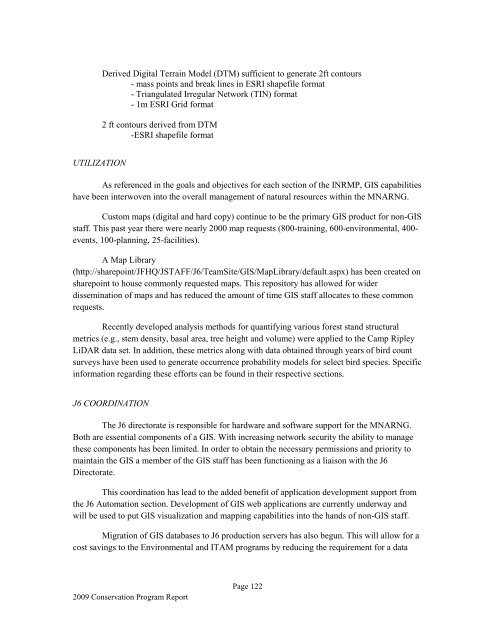camp ripley and arden hills minnesota army national guard training ...
camp ripley and arden hills minnesota army national guard training ...
camp ripley and arden hills minnesota army national guard training ...
You also want an ePaper? Increase the reach of your titles
YUMPU automatically turns print PDFs into web optimized ePapers that Google loves.
UTILIZATION<br />
Derived Digital Terrain Model (DTM) sufficient to generate 2ft contours<br />
- mass points <strong>and</strong> break lines in ESRI shapefile format<br />
- Triangulated Irregular Network (TIN) format<br />
- 1m ESRI Grid format<br />
2 ft contours derived from DTM<br />
-ESRI shapefile format<br />
As referenced in the goals <strong>and</strong> objectives for each section of the INRMP, GIS capabilities<br />
have been interwoven into the overall management of natural resources within the MNARNG.<br />
Custom maps (digital <strong>and</strong> hard copy) continue to be the primary GIS product for non-GIS<br />
staff. This past year there were nearly 2000 map requests (800-<strong>training</strong>, 600-environmental, 400events,<br />
100-planning, 25-facilities).<br />
A Map Library<br />
(http://sharepoint/JFHQ/JSTAFF/J6/TeamSite/GIS/MapLibrary/default.aspx) has been created on<br />
sharepoint to house commonly requested maps. This repository has allowed for wider<br />
dissemination of maps <strong>and</strong> has reduced the amount of time GIS staff allocates to these common<br />
requests.<br />
Recently developed analysis methods for quantifying various forest st<strong>and</strong> structural<br />
metrics (e.g., stem density, basal area, tree height <strong>and</strong> volume) were applied to the Camp Ripley<br />
LiDAR data set. In addition, these metrics along with data obtained through years of bird count<br />
surveys have been used to generate occurrence probability models for select bird species. Specific<br />
information regarding these efforts can be found in their respective sections.<br />
J6 COORDINATION<br />
The J6 directorate is responsible for hardware <strong>and</strong> software support for the MNARNG.<br />
Both are essential components of a GIS. With increasing network security the ability to manage<br />
these components has been limited. In order to obtain the necessary permissions <strong>and</strong> priority to<br />
maintain the GIS a member of the GIS staff has been functioning as a liaison with the J6<br />
Directorate.<br />
This coordination has lead to the added benefit of application development support from<br />
the J6 Automation section. Development of GIS web applications are currently underway <strong>and</strong><br />
will be used to put GIS visualization <strong>and</strong> mapping capabilities into the h<strong>and</strong>s of non-GIS staff.<br />
Migration of GIS databases to J6 production servers has also begun. This will allow for a<br />
cost savings to the Environmental <strong>and</strong> ITAM programs by reducing the requirement for a data<br />
2009 Conservation Program Report<br />
Page 122
















